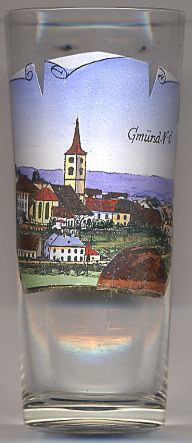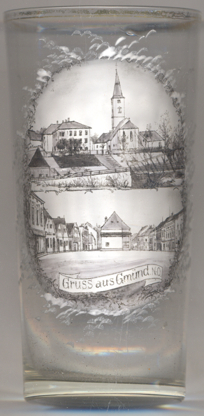

|
| ÖSTERREICH | AUSTRIA |
| Bundesland: Niederösterreich | Lower Austria |
| Bezirk: Gmünd |

 Gmünd is situated at elevation of 485 m at the confluence of he river Lainsitz and the stream Braunaubach
in the northerwestern part of the Waldviertel region of Lower Austria, directly at the Czech border.
Gmünd is the administrative seat of the district of the same name. The municipality has a population of about 5,600 (2010).
Gmünd is situated at elevation of 485 m at the confluence of he river Lainsitz and the stream Braunaubach
in the northerwestern part of the Waldviertel region of Lower Austria, directly at the Czech border.
Gmünd is the administrative seat of the district of the same name. The municipality has a population of about 5,600 (2010).
The earliest written mention of this place (concurus duorum rivulorum) is found in a border contract of 1179 between Bohemia and Austria. The original Latin name means 'confluence of two streams which is also the origin of the older German name as Gemünd literally means 'confluence'. An important factor in the history of the town was the opening in 1869 of the Franz-Josephs-Bahn, the railroad leading from Vienna to Klosterneuburg, Tulln, Absdorf-Hippersdorf (branch to Krems an der Donau), Eggenburg and Gmünd. From here, one branch of the railroad lead to Tábor and Prague and another one to České Budějovice. Gmünd was the operational centre of this railroad. In 1918, Gmünd's quarter of Gmünd-Bahnhof (previously Unterwielands) on the left bank of the Lainsitz (Czech: Lužnice) became part of Czechoslovakia and in 1920 was renamed České Velenice. Only between 1938 and 1945, České Velenice was again part of Gmünd (Gmünd III).
The  parish church Sankt Stefan
goes back to a Romanesque church of the 12th and 13th century.
The oldest document mentioning the church dates from 1278/1280 and refers to the church as the seat of a vicarage. In 1382, it became a parish church.
In the 13th century the nave was enlarged, and in the 14th century the Gothic chancel was added. In the 15th century further enlargements of the naves
and of the vaulting of the main nave followed. The eastern tower of the church was destroyed by a large fire in 1852. The tower was never rebuilt. Instead,
the western tower was added in 1852–1854. The interior decorations in Gothic revival style were added in 1903.
The chancel was enlarged in 1981/1982 by the Austrian architect Clemens Holzmeister.
parish church Sankt Stefan
goes back to a Romanesque church of the 12th and 13th century.
The oldest document mentioning the church dates from 1278/1280 and refers to the church as the seat of a vicarage. In 1382, it became a parish church.
In the 13th century the nave was enlarged, and in the 14th century the Gothic chancel was added. In the 15th century further enlargements of the naves
and of the vaulting of the main nave followed. The eastern tower of the church was destroyed by a large fire in 1852. The tower was never rebuilt. Instead,
the western tower was added in 1852–1854. The interior decorations in Gothic revival style were added in 1903.
The chancel was enlarged in 1981/1982 by the Austrian architect Clemens Holzmeister.


Another place with a similar name that is part of this collection is: |
![[scale]](lineal.jpg)